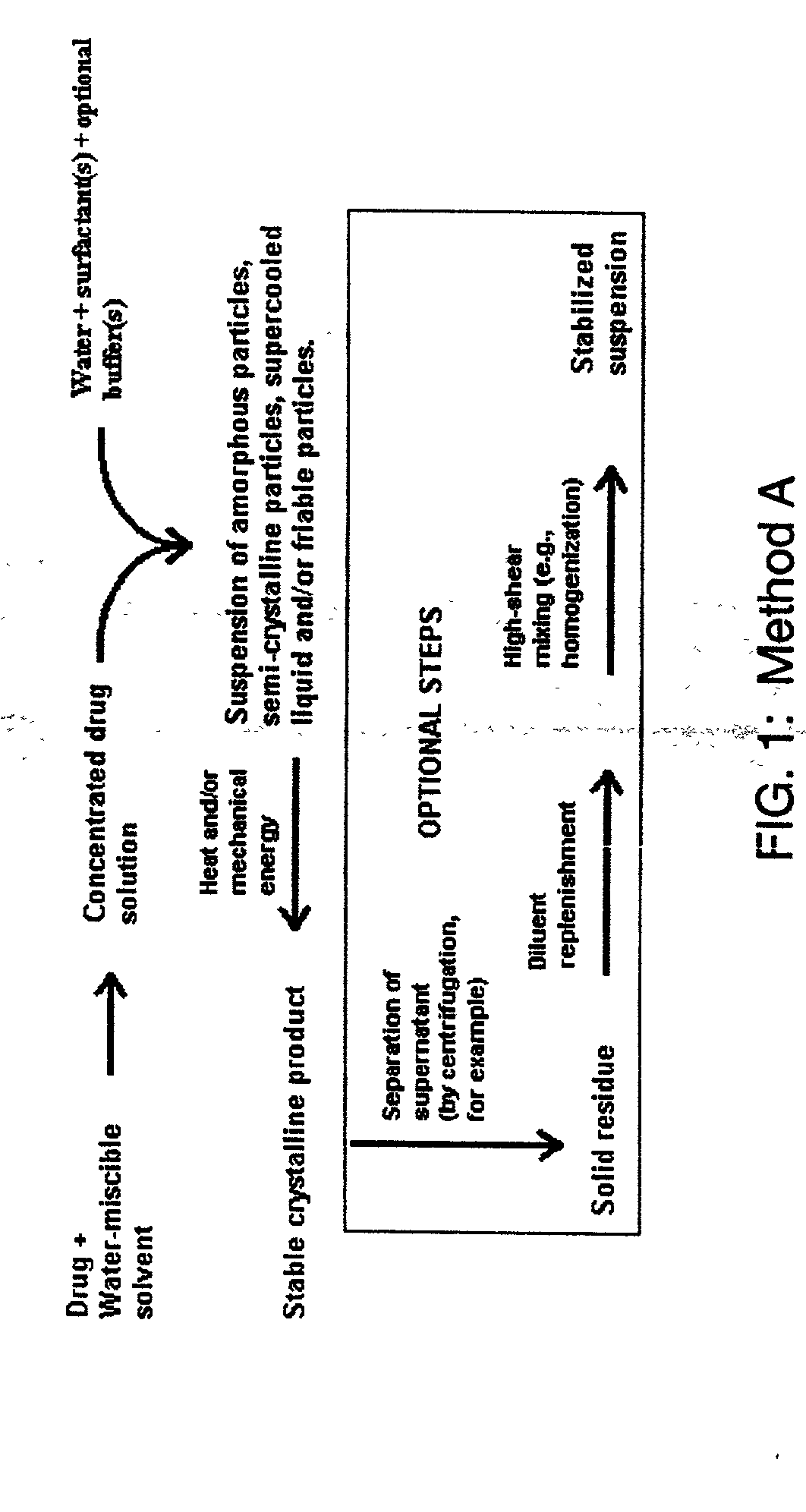Microprecipitation method for preparing submicron suspensions
a microprecipitation method and suspension technology, applied in colloidal chemistry, transportation and packaging, pharmaceutical product form change, etc., can solve the problem of not revealing the steps of changing the morphology of raw materials, undesirable to use high-energy equipment such as sonicators and homogenizers, and the number of pharmaceutical drugs being formulated that are poorly soluble or insoluble in aqueous solutions. to achieve the effect of facilitating the processing and facilitating the processing
- Summary
- Abstract
- Description
- Claims
- Application Information
AI Technical Summary
Benefits of technology
Problems solved by technology
Method used
Image
Examples
example 1
Preparation of Itraconazole Suspension by Use of Process Category 1, Method A With Homogenization
[0074] To a 3-L flask add 1680 mL of Water for Injection. Heat liquid to 60-65.degree. C., and then slowly add 44 grams of Pluronic F-68 (poloxamer 188), and 12 grams of sodium deoxycholate, stirring after each addition to dissolve the solids. After addition of solids is complete, stir for another 15 minutes at 60-65.degree. C. to ensure complete dissolution. Prepare a 50 mM tris (tromethamine) buffer by dissolving 6.06 grams of tris in 800 mL of Water for Injection. Titrate this solution to pH 8.0 with 0.1 M hydrochloric acid. Dilute the resulting solution to 1 liter with additional Water for Injection. Add 200 mL of the tris buffer to the poloxamer / deoxycholate solution. Stir thoroughly to mix solutions.
[0075] In a 150-mL beaker add 20 grams of itraconazole and 120 mL of N-methyl-2-pyrrolidinone. Heat mixture to 50-60.degree. C., and stir to dissolve solids. After total dissolution is ...
example 2
Preparation of Itraconazole Suspension by Use of Process Category 1, Method A With Ultrasonication
[0082] To a 500-mL stainless steel vessel add 252 mL of Water for Injection. Heat liquid to 60-65.degree. C., and then slowly add 6.6 grams of Pluronic F-68 (poloxamer 188), and 0.9 grams of sodium deoxycholate, stirring after each addition to dissolve the solids. After addition of solids is complete, stir for another 15 minutes at 60-65.degree. C. to ensure complete dissolution. Prepare a 50 mM tris (tromethamine) buffer by dissolving 6.06 grams of tris in 800 mL of Water for Injection. Titrate this solution to pH 8.0 with 0.1 M hydrochloric acid. Dilute the resulting solution to 1 liter with additional Water for Injection. Add 30 mL of the tris buffer to the poloxamer / deoxycholate solution. Stir thoroughly to mix solutions.
[0083] In a 30-mL container add 3 grams of itraconazole and 18 mL of N-methyl-2-pyrrolidinone. Heat mixture to 50-60.degree. C., and stir to dissolve solids. After ...
example 3
Preparation of Itraconazole Suspension by Use of Process Category 1, Method B With Homogenization
[0086] Prepare a 50 mM tris (tromethamine) buffer by dissolving 6.06 grams of tris in 800 mL of Water for Injection. Titrate this solution to pH 8.0 with 0.1 M hydrochloric acid. Dilute the resulting solution to 1 liter with additional Water for Injection. To a 3-L flask add 1680 mL of Water for Injection. Add 200 mL of the tris buffer to the 1680 mL of water. Stir thoroughly to mix solutions.
[0087] In a 150-mL beaker add 44 grams of Pluronic F-68 (poloxamer 188) and 12 grams of sodium deoxycholate to 120 mL of N-methyl-2-pyrrolidinone- . Heat the mixture to 50-60.degree. C., and stir to dissolve solids. After total dissolution is visually apparent, stir another 15 minutes to ensure complete dissolution. To this solution, add 20 grams of itraconazole, and stir until totally dissolved. Cool the itraconazole-surfactant-NMP solution to room temperature.
[0088] Charge a syringe pump (two 60-m...
PUM
| Property | Measurement | Unit |
|---|---|---|
| particle size | aaaaa | aaaaa |
| particle size | aaaaa | aaaaa |
| diameter | aaaaa | aaaaa |
Abstract
Description
Claims
Application Information
 Login to View More
Login to View More - R&D
- Intellectual Property
- Life Sciences
- Materials
- Tech Scout
- Unparalleled Data Quality
- Higher Quality Content
- 60% Fewer Hallucinations
Browse by: Latest US Patents, China's latest patents, Technical Efficacy Thesaurus, Application Domain, Technology Topic, Popular Technical Reports.
© 2025 PatSnap. All rights reserved.Legal|Privacy policy|Modern Slavery Act Transparency Statement|Sitemap|About US| Contact US: help@patsnap.com



